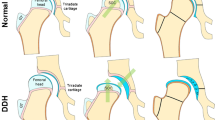Abstract
Purpose
The purpose of this study is to define the normal range of acetabular abduction and anteversion in relation to pelvic anatomy as depicted on conventional CT scan.
Methods
We retrospectively reviewed 100 pelvic CT scans performed on patients presenting for evaluation of non-orthopaedic pathology. The study group consisted of 58 women and 42 men, aged between 18 and 88 years. Standard imaging protocol included an anteroposterior (AP) topogram with contiguous 5-mm thick axial images from the superior margin of the iliac crest to the lesser trochanter of the femur. The acetabular abduction was measured from the AP topogram by obtaining the angle between a line drawn from the acetabular teardrop to the lateral acetabular margin and a horizontal line between the ischial tuberosities. Acetabular anteversion was measured on axial images at the level of the mid-femoral head.
Results
We found the mean acetabular abduction to be 39 degrees (standard deviation 4 degrees, range 27 to 51 degrees) and the mean acetabular anteversion to be 23 degrees (standard deviation 5 degrees, range 12 to 39 degrees). Data suggests that acetabular anteversion may average 2.7 degrees lower in males than females and increase slightly with age, while abduction may tend to decrease with age. Ninety percent of patients had acetabular abduction between 31 and 46 degrees; the 90% central range for acetabular anteversion was estimated to be from 14 to 31 degrees.
Conclusion
CT scanning is useful in accurately defining the normal range of acetabular abduction and antiversion. Knowledge of this normal anatomy will allow accurate assessment of acetabular component position as delineated on conventional CT scanning.




Similar content being viewed by others
References
Charnley J. Total hip replacement by low-friction arthroplasty. Clin Orthop 1970;72:7–21
Lewinnek GE, Lewis JL, Tarr R, Compere CL, Zimmerman JR. Dislocations after total hip-replacement arthroplasties. J Bone Joint Surg Am 1978;60:217–220
Murray DW. The definition and measurement of acetabular orientation. J Bone Joint Surg Br 1993;75:228–232
Hassan DM, Johnston GH, Dust WN, Watson LG, Cassidy D. Radiographic calculation of anteversion in acetabular prostheses. J Arthroplasty 1995;10:369–372
Anda S, Terjesen T, Kvistad KA. Computed tomography measurements of the acetabulum in adult dysplastic hips: which level is appropriate? Skeletal Radiol 1991;20:267–271
Maruyama M, Feinberg JR,Capello WN, D’Antonio JA. The Frank Stinchfield Award: Morphologic features of the acetabulum and femur: anteversion angle and implant positioning. Clin Orthop 2001;393:52–65
Murphy SB, Kijewski PK, Millis MB, Harless A. Acetabular dysplasia in the adolescent and young adult. Clin Orthop 1990;261:214–223
Giori NJ, Trousdale RT. Acetabular retroversion is associated with osteoarthritis of the hip. Clin Orthop 2003;417:263–269
Author information
Authors and Affiliations
Corresponding author
Rights and permissions
About this article
Cite this article
Stem, E.S., O’Connor, M.I., Kransdorf, M.J. et al. Computed tomography analysis of acetabular anteversion and abduction. Skeletal Radiol 35, 385–389 (2006). https://doi.org/10.1007/s00256-006-0086-4
Received:
Revised:
Accepted:
Published:
Issue Date:
DOI: https://doi.org/10.1007/s00256-006-0086-4




